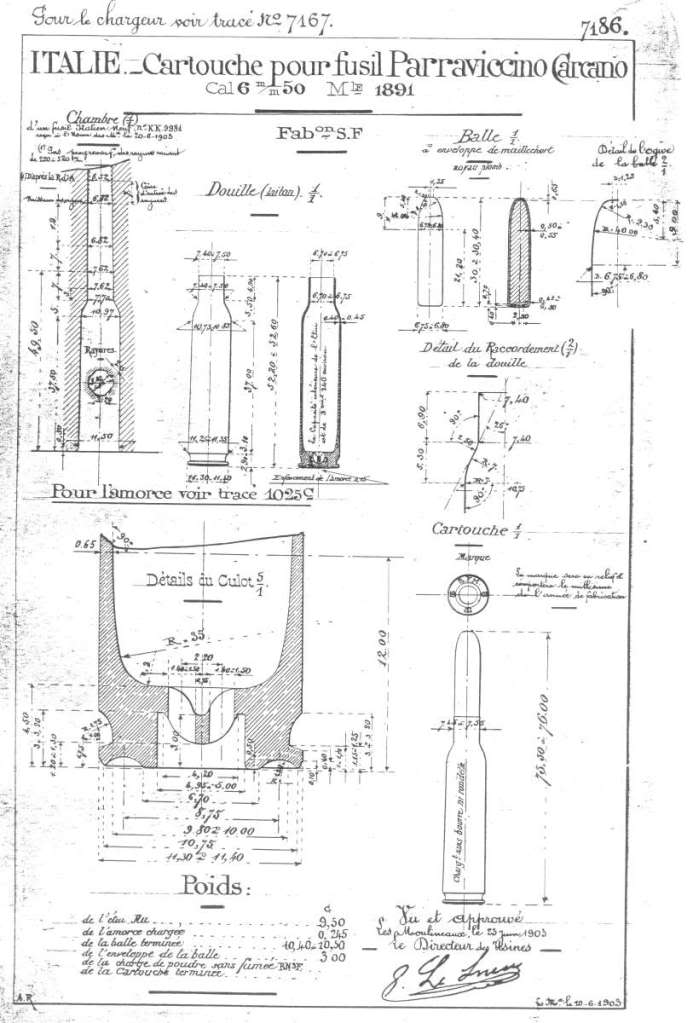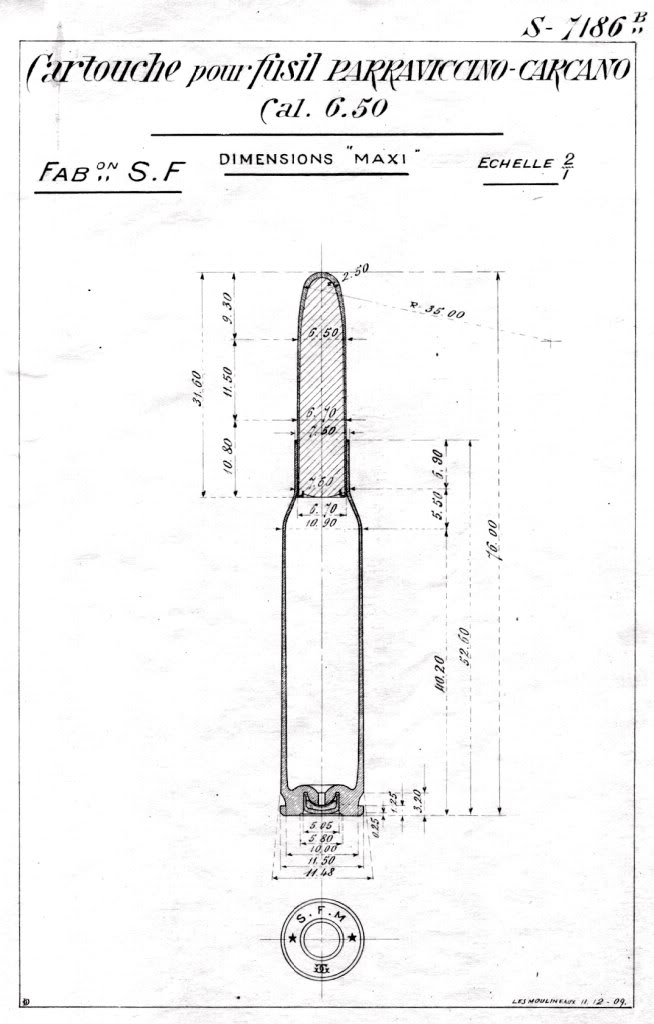The 1890’s was a very interesting period of cartridge development. The Italians were effectively the first to consider the 6,5mm as a viable military calibre. One of the chief designers was Luigi Scotti, Chief Inspector of the Pirotecnica di Bologna. He was instrumental in the design of the M91 cartridge during the 1890-92 trials. The early cases were rimmed but taking note of the rimless designs by German and Belgian manufacturers, adopted the rimless case which became the M91 cartridge. The work did by the Italians with their various case designs gave rise to nearly all the other 6,5mm military cases developed during this period.
A version of the M1890 case was adopted by Mannlicher, which became the 6,5x53R model M93 Romanian/M95 Dutch Mannlicher. This in turn led to a rimless version, namely the 6,5×54 Mannlicher Schoenauer. The Germans, who had submitted trial rifles in 1890-91 to the Italian Trials committee and had been experimenting with small calibres for military rifles, came out with the 6,5×55 model M94 Swedish Mauser, based on the M88 case design. The 6,5x54SR Daudetau case was designed in 1894-95, on a variation of an earlier Nagant Freres case. This later developed into the 7.62x54R Nagant. In a joint German/Portuguese development, Mauser developed the 6.5×58 Portuguese in 1904, again on the M88 base. Even the Japanese adopted their version of the 6.5mm in 1897 with the 6.5×50 Arisaka Type 30.
The first cartridges were called M91 and had a flat base and used a two based powder developed by Nobel, namely Ballistite with a wad of cotton wool. This gave some problems regarding throat erosion and the Italians devised their own powder, namely Solenite in 1896. From the introduction of Solenite the headstamp included an ‘X’ at the 9 o’clock position indicating the use of Solenite, which leads to the assumption that Ballistite was also still used during this period. Solenite was similar to Filite and Cordite, but the nitro-glycerine content being reduced to 33 per cent, with a corresponding increase in the nitrocellulose content. The method of manufacture of Solenite was similar to that of cordite. Capua Arsenal used the ‘X’ until 1911 and until around 1909 by the Bologna Arsenal. The design also changed in 1895 with the introduction of a recessed/grooved base and the headstamp was done in relief. The last major change happened in 1907 when the bullet was made with a groove near the base to facilitate crimping.
The headstamp system used by the Government Arsenals bore the initials of the head inspector at 12o’clock, with the arsenal and the date at the 6 o’clock position. At this stage, many of the inspectors’ names are still not known, and there were rumours that the Italian Government still regards this information as “classified”. The main arsenals were at Capua, Bologna and Turin, although it is possible that Turin did not produce any Carcano ammunition.
M91 Carcano ammunition was originally made without neck crimping (1892-95). Field experience showed problems with the primer leakages, leading to the adoption of the recessed base with the relief headstamp in a large circular groove in the head. This groove acts as a self-sealing crimp on the moment of firing and added hardness to the head, removing the risk of primer pocket expansion. A slight bolt face redesign made sure that the inner primer ring was “swaged” on the impact of firing, thus improving the gas seal between head and primer cup. It was also found that soldiers “improved” their ammunition by adding or subtracting powder from the cartridges and also that bullets moved in cases under recoil or under the vibration of horse drawn wagons during field transport. Thus, with the other improvements in the M1895 cartridge (or M91/95 as occasionally shown on packets), three triangular deep stab crimps were introduced, as well as a wide crimping cannelure on the bullet (no serrations).
This was standard practice up to the late 1930’s, when several of the commercial makers (SMI and BPD) commenced using the “neck cone” or crimp method, as there had been found during WW I and then during the Abyssinian war, that a lot of cases cracked at the crimp position (either from over stressed brass or age) so with the introduction of Gilding Metal jackets (original M91 jackets were CN), the mouth crimp was introduced as well (around 1939-40). Mouth crimping dies were easier to make than stab crimp dies and “punches”. The standard Ball projectile for the M91 and M91/95 cartridge was always the 162gr round nose as described. After WW 1, some experiments with Spitzer AP and Special ammo was trialled, but no suitable projectile was developed and as of 1938, the new spitser 7,35 cartridge had been introduced. With the onset of war, any “experimentation” was out of the question, and so the Italians persevered with the 6,5mm–162 grain RN cylindrical projectile.
 Carcano M1891 Carbine
Carcano M1891 Carbine
GOVERNMENT ARSENALS
PIROTECNICA DI BOLOGNA and CAPUA
Bologna and Capua were the two arsenals used in the manufacture of 6.5 Carcano ammunition. The headstamps used the initials of the inspector at the 12 o’clock position and the arsenal and date at the 6 o’clock position. To this day, many of the inspectors’ names are not know for a variety of reasons namely, records were destroyed during the war, or the Italian Government still has not released the names of these persons. The headstamp variations below show the inspectors that were employed at the Bologna and Capua arsenals. The style was that the last name was first.
An X on the 9 o’clock position indicated that the round was loaded with Solenite
A star on the 9 o’clock position indicates a proof load.
Headstamp variations on Bologna Arsenal cartridges.
B.P is assumed to be Pietro Boschesi







C.A were the initials for Alfredo Cavalli



FP is unknown at this stage

RM were the initials for Mario Rubino

TM is unknown at this stage


TR is unknown at this stage

Headstamp variations on Capua Arsenal cartridges
A.A were the initials for Aldamo Aldo



B.P is assumed to be Pietro Boschesi. Also known on Bologna arsenal

C.A were the initials for Alfredo Cavalli


ES is unknown at this stage



FP is unknown at this stage


L.N were the initials for Nicola Leggiadore


P.V were the initials for Vincenzo Pascarello


SA is unknown at this stage

SG is unknown at this stage

TR is unknown at this stage

ZG were the initials for Gaetano Zangari

LOAD VARIATIONS FROM BOLOGNA AND CAPUA
BLANK

 Early M91 blank with flat base
Early M91 blank with flat base
M91/95
Same as the M91 blank, except for the grooved base.

M91/1910 used the same case and loading as the M91/95, but with hollow poplar wood bullet, and stained.



The specimen below is the MAGISTRI Machine gun blank. Uses a corrugated brass foil that was loaded with a lead/graphite mixture.

GRENADE BLANK
First version was a normal case with a small cone crimp with felt disk wad.


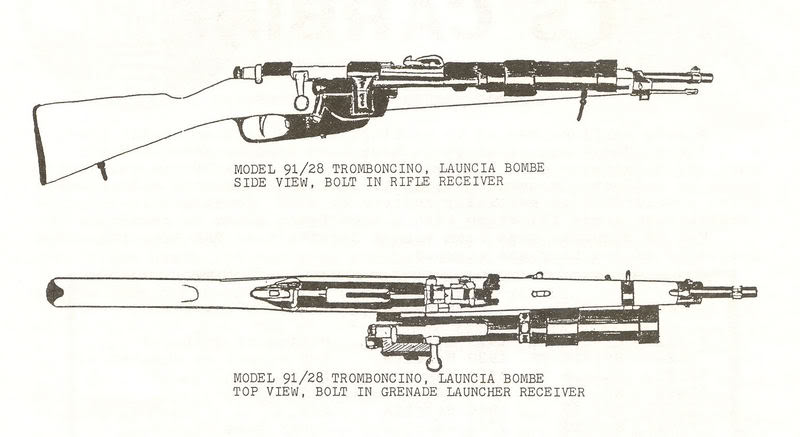
The grenade-launching device attached to the right side of the short rifle made specifically for its use was the Modello 91/28 Tromboncino, also called Moschetto Modello 91 TS.
 Carcano Modello 91/28
Carcano Modello 91/28
SHORT RANGE
The M91 was the first model for gallery practice, adopted in October 1913. Used a standard brass case with a steel tube insert at the base and was loaded with the 4x18R propulsive blank and a lead bullet or ‘cappellozzo’ which means ‘top hat’ that resembles the lead bullet. The Cartuccia per Tiro Ridotto was based on the Austrian ‘Conus’ principle.



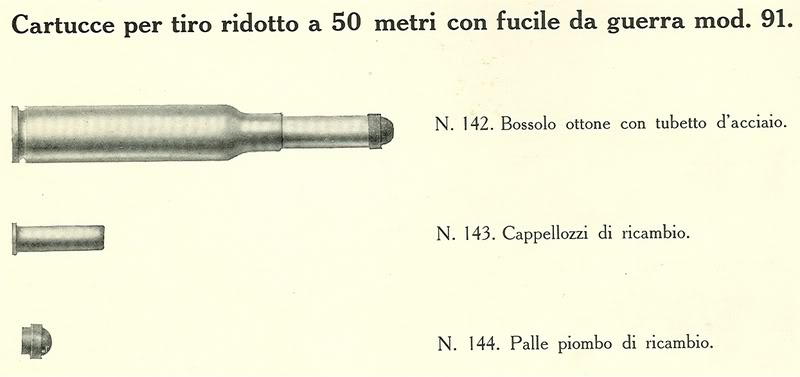
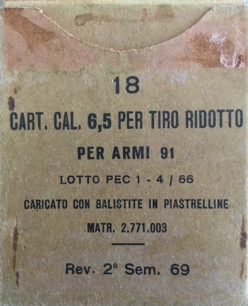 Box picture from 2017 ECRA Show, Walenstadt Switserland
Box picture from 2017 ECRA Show, Walenstadt Switserland

REDUCED CHARGE/FRANGIBLE GALLERY
This load was used primarily in shooting clubs (ITALIAN NATIONAL SHOOTING ASSOCIATION) as well as open air troop manoeuvres. The bullet is shorter than a standard ball load. The internal structure of the neck was modified to accept this smaller bullet and the bullet was filled with lead and compressed sand with a small lead tip visible. After WW1 the tips were painted green for identification.


FRANGIBLE
The M91/95 was filled with a aluminium cylinder and lead balls.


M1937 MAGISTRI
The M37 was a simplification on the M91/95 with a different construction, whereby the aluminium and lead pellets were replaced by lead powder and sand. Early cartridges were CN but it was replaced in 1940 with GM jackets.


GUARD/ANTI-RIOT
Utilised a 250gr. bullet inserted deeply in the case so that the total OAL is equal to a normal load. The bullet consisted of a brass tube with three longitudinal slits containing 5 lead cylinders that were bisected. Upon exiting the barrel, the slits disintegrate and the lead cylinders dispersed like a shot load. Later versions did not have the CN tip.


DUMMY
The earlier versions used a brass sheet with four longitudinal grooves with the primer replaced by a leather disk. The later M1909 versions replaced the leather disk with a wooden dowel that ran through the length of the case, with the tip shaped like a bullet, keeping the grooves.



ARMOUR PIERCING
 Used a spitser bullet with steel core.
Used a spitser bullet with steel core.
TRACER
 Presumably used during WW1 against planes and airships. Red tip.
Presumably used during WW1 against planes and airships. Red tip.
____________________
Bullet variations on Bologna and Capua ammunition. All specimens shown at 200% scale
1.  2.
2.  3.
3.  4.
4.  5.
5.  6.
6.  7.
7.  8.
8. 9.
9.  10.
10. 
1. Blank M91/95
2. – 4. Blank M91/1910
5. Magistri M/G Blank
6. M39 Gallery
7. Frangible/Gallery CN with exposed lead tip
8. Frangible/Gallery CN Green tipped for identification
9. M91/95 Frangible
10. M91/95 Frangible
11.  12.
12.  13.
13.  14.
14.  15.
15.  16.
16.  17.
17.  18.
18.  19.
19.  20.
20.  21.
21. 
11. M1937 Magistri Frangible, CN
12. M1937 Magistri Frangible GM
13. Guard/Anti-Riot with CN tip
14. Guard/Anti-Riot
15. – 17. Dummy Loadings
18. Armour Piercing
19. Tracer
20. CN
21. GMCS
 Carcano M38 Rifle
Carcano M38 Rifle
 Carcano M38 Cavalry Carbine
Carcano M38 Cavalry Carbine
NON GOVERNMENT ARSENALS
BOMBRINI, PARODI DELFINO
The company was founded in 1912 by Senator Giovanni Bombrini and Senator Leopoldo Parodi Delfino.






Dummy cartridge using a wooden dowel insert. The production of laquered steel cases started late in 1941, before the capitulation to Germany in September 1943 after which it was made under German control in the occupied areas both for Wehrmacht use as well as the Republican troops.
DIREZIONE CENTRALE ESERCITO. 1953-1955


This cartridge is the M.37 Frangible, or “Magistri”. Consists of a GM cap with 2 lead cylinders together with compressed sand.
LEON BEAUX & CO., MILAN.



SOCIETA ITALIANA GENERALE PER MUNIZIONI ED ARMI, BOLOGNA. (SIGMA)


Società Italiana Generale per Munizioni ed Armi (SIGMA) of Bologna, which was a subcontractor of Pirotecnico di Bologna, or Bologna Ammunition Factory. This company was established in Casaralta on November 6, 1915 and closed in 1919.
SOCIETA METALLURGICA ITALIANA, FLORENCE.










Variations on the SMI headstamp
The stars on the 2nd and 3rd specimens are for proof loadings, however these WW1 loaded cartridges may in fact be ordinary ball loadings, as the cases might have been used because of war demands.







1. CN Bullet
2. Wood Blank, Headstamp SMI 915. Base had 4 slits added
3. Wood Dummy, Headstamp SMI 927, utilised a wooden dowel insert
4. Gallery Frangible. Cartridge had a projection in the neck to facilitate the shorter bullet. Would have been used by the Italian National Shooting Association. Lead core with compressed sand filling and coloured green for identification.
5. GMCS Bullet, unknown why it was stained black
6. Ordinary GMCS
7. Ordinary GMCS, with laquered steel case.
 Case was stamped ‘HEGE 6.5 Caro:’ – this is to comply with German regulations.
Case was stamped ‘HEGE 6.5 Caro:’ – this is to comply with German regulations.
 Grenade blank
Grenade blank
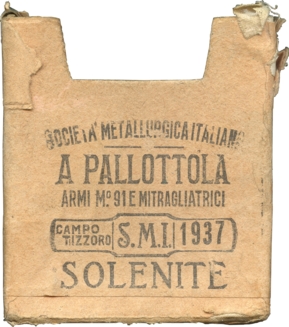
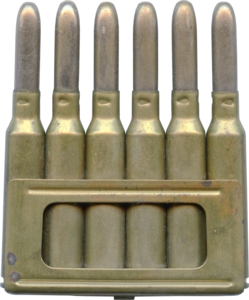 Example of box with loading clip. Headstamp is SMI 937.
Example of box with loading clip. Headstamp is SMI 937.
OTHER MANUFACTURERS
SOCIETE FRANCAISE DES MUNITIONS, ISSY LES-MOULINEAUX.


HIRTENBERG



Contract loading by Hirtenberg Austria for Italy. Note the two different case neck crimpings.
ASSMANN



These blanks were packed in paper boxes/packets in the same way that it was done for normal Austrian “Knallpatrone” for the 7,62×51 NATO. There are 40 rounds packed in thin brownish paper bags, imprinted with “Suedsteirische Metallindustrie (adress) 40 Knallpatronen 7,62×51. Above the imprint it was stamped “Italienische” and in most cases the lettering for 7,62×51 was blackened out by an ink-roller so that only the section reading ‘40 Knallpatronen’ can be seen. Because so few of these blanks were manufactured for the Carcano, it was not deemed necessary to print packets specifically for it. There are a number of calibers produced by the Suedsteirische Metallindustrie (Assmann). The dimensions on most of them are not exactly the same as normal manufactured ammunition, but are still functional. (Information courtesy: Peter Petrusic/IAA Forum).
COMMERCIAL














In the 1950’s, the Italian Government decided to check and refurbish their WWII weapons inventory, many of them being still in use with the Italian Army and the Police. This is the reason that we find several obsolete WW1 calibers, such as the 6.5mm Carcano and the 8mm Breda were still being manufactured, or at least available from cartridge manufacturers’ catalogues some 10 years after the war had ended. Most of the weapons checked were in good serviceable condition, but in contrast the ammunition stocks were getting too old and unreliable. It was decided to order a goodly amount of 6,5mm Carcano rounds from the USA. Later on, when Italy joined NATO, their weapons had to be standardized to NATO specifications, so the old rifles and carbines were sold off as surplus and the cartridge contracts reduced and the quantities that had already arrived in Italy being sent back to the USA and Canada to be sold off as surplus.
The white 20-round cardboard 6,5mm Carcano ammunition boxes were mostly sold in the US west and Midwest gunshops. They had been made by the WESTERN CARTRIDGE Co., division of Olin industries Inc., at East Alton, Illinois and four lots of one million rounds each were manufactured in 1954. These cartridges are well known to collectors, with their ‘WCC 6.5 mm‘ headstamp (see above), brass case, flat brass primer with a red primer annulus and a round tipped 144 grain gilding metal jacketed lead core bullet, featuring a knurled -neck cannelure. All the stories about an alleged order from the Warren Commission for a new manufacture of this ammunition, to test the murder weapon are pure fabrication, as good quantities of the exact lots bought by Lee Oswald were easily available. On trial tests, approximately 200 rounds were fired by various government agencies and 700 more by Dr. John K. Lattimer M.D. and his collaborators in an extremely interesting study published in the WOUND BALLISTIC REVIEW (International Wound Ballistic Association) Vol.2, No2, 1995. (ECRA newsletter 369-23 Feb 1996)
 Carcano M1941 Rifle
Carcano M1941 Rifle
